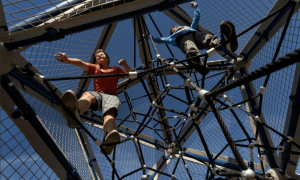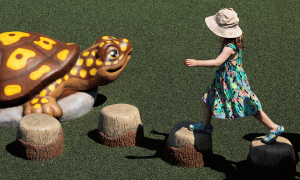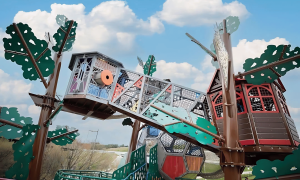How to Build a Playground for a School, Church or Youth Center
We are frequently asked "how do I get started building a playground?" Many times PTO groups or faith centers are working on a playground project for the first time, and the process can seem overwhelming. Playgrounds are fun, and we think building them should be fun, too. Here are five tips to help you get started:
1. Budget and Fundraising
As with any big project, setting a budget is an important first step. One of the first questions that might cross your mind is, "Well, how much does a playground cost...how much should we budget for a playground?"
There's a lot that goes into determining the price of a new playground. A typical commercial play system costs between $20,000 and $50,000 for the playground equipment, but smaller compact play systems priced between $10,000 and $20,000 can provide a surprising amount of play value. As with any project, the larger the system, the higher the cost, and systems that include custom or themed elements add to the price. You'll need to budget for installation costs, either by certified installers or by certified installation supervisors who oversee volunteers as part of a community build. Also plan for the cost of safety surfaces like Engineered Wood Fiber, Synthetic Turf, Rubber Tiles or Poured in Place Rubber. Finally, you'll need to consider the cost of freight, tax and any other site preparation construction that is necessary prior to installation. These additional costs can vary by region, and you should consult your playground project expert for a detailed proposal or price quote.
So how can you raise money or find grants and funding for your new playground?
In 2016, over $360 billion charitable donations were made in America, alone. Nearly $60 billion was donated to health and recreation-related projects.* Organizations across the country provide grants to help churches, schools and other youth organizations build playgrounds. We've compiled a list of funding sources in our Playground Funding Guide to help you find a funding partner.
2. Space to Play
Many first time playground customers ask us, "How much space do I need to build a new playground?" Safety standards require a specific amount of space around each play structure or element on a playground. This is called a "Use Zone."
One of our most popular systems for small spaces is Coghill. It has a Use Zone of 25' x 30' -- this means the area in which you install Coghill needs to be at least 25 feet by 30 feet wide. Coghill can accommodate 20 to 25 children at one time, and features a lot of play activities like two slides, two different styles of climbers and a roof for shade.
Whether you have a little space or a lot, a GameTime playground professional can help you select the right mix of products to fit your space and budget.
3. Installing the Playground
Once you've selected your playground equipment, determined how much space you need and raised the necessary funds, it's time to plan for installation. You might be asking yourself, "How do I install an entire playground for my school, church or youth center?" You're not alone in this! And you have options.
Make it Easy on Yourself
You can choose a full, turnkey installation, which means your local GameTime representative will work with our network of certified installers to install the playground all the way -- from roofs and slides to surfacing and play curbs. You won't have to worry about a thing, because our certified installers are playground experts. They go through extensive training by the same people who manufacture the equipment, and they will ensure your playground is installed correctly and is compliant with all standards.
Get the Community Involved
Another option is a community build. We purposely designed our playgrounds to make community builds easier. All of our play systems use Direct Bolt® connections, which means our parts come with the connections preinstalled, so when you and your neighborhood come together on a Saturday afternoon, the pieces will fit together easily and intuitively. It also means the parts ship from the factory compliant with safety standards. There's no need to continually measure and adjust connections during installation, and there's no guesswork.
Community builds are a great way to engage community members, families and other people who were involved with the project to help them feel a sense of ownership and pride in the playground. It's a wonderful team-building experience.
Every GameTime play system ships with detailed installation instructions, but enlist the help of one or two certified installers to supervise your crew of volunteers. Their assistance will be valuable as you set up your new playground.
4. Warranty and Maintenance
"How long will a playground last?"
"How can I make sure our playground is in good condition?"
These are two questions from a recent town hall meeting, and they are questions we receive a lot. With today's steel and plastic materials, your GameTime playground should last for years and years with proper maintenance. We back all of our components with one of the industry's best warranties, including a limited lifetime warranty on uprights and hardware. If you ever need repairs or replacement parts, we are only a phone call or email away, and we have representatives in all 50 states, in 26 countries and on six continents. Wherever you are, we're local.
Providing regular maintenance will help keep your playground in top shape and prolong its life. To help you keep up a routine maintenance schedule, we've published a Playground Maintenance Guide with lots of information, checklists and more.
5. Surfacing
Safety surfacing is a piece of the project that is often overlooked. You can't just set up a playground on grass or dirt. And you can't install it on asphalt or gravel like they did a LONG time ago. Modern safety surfaces attenuate falls -- that's a fancy way of saying they provide cushioning when a child falls down. Safety standards require approved safety surfacing, and GameTime offers various options for our play equipment.
Each surfacing option has its benefits. Engineered Wood Fiber (EWF) has a lower initial cost, but requires frequent maintenance and replenishment. Poured In Place Rubber has a higher initial cost, but requires less maintenance and is a more accessible and inclusive surface. You can also choose recycled rubber tiles or synthetic turf. All of our surfacing options meet the safety standards for playgrounds and are engineered to work with our play equipment.
Your local playground expert is here to help you figure out the best surfacing for your space.
Next Steps
These are just the basics to keep in mind as you begin your playground-building research. There are other things to consider -- like using manufactured shade structures or natural shade to keep the play area cool, whether you should add site amenities like benches or trash receptacles, when to choose plastic slides or metal slides, etc. Because there are so many options involved with building a playground, it's important to work with an experienced playground professional who can walk you through the entire process, and support you long after the children are having fun on the playground.
Have more questions? Please contact your local rep for more personalized advice! We love playgrounds and are happy to help.
*Giving USA 2016: The Annual Report on Philanthropy






